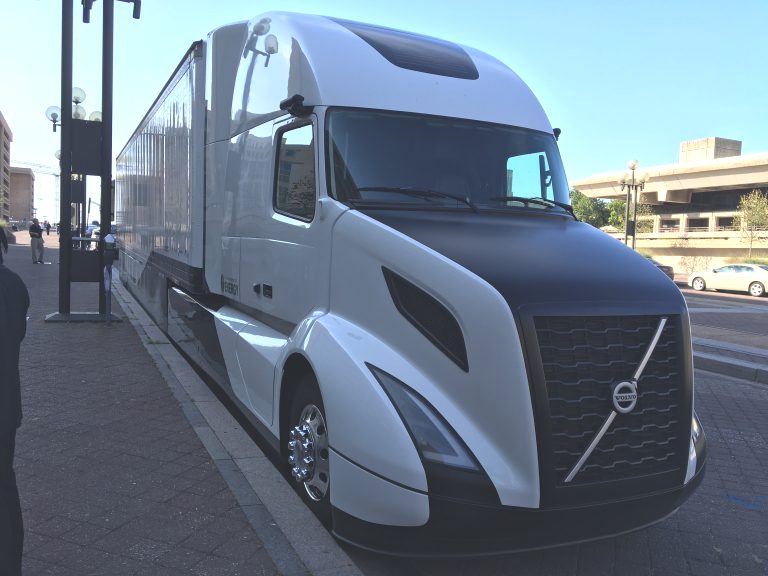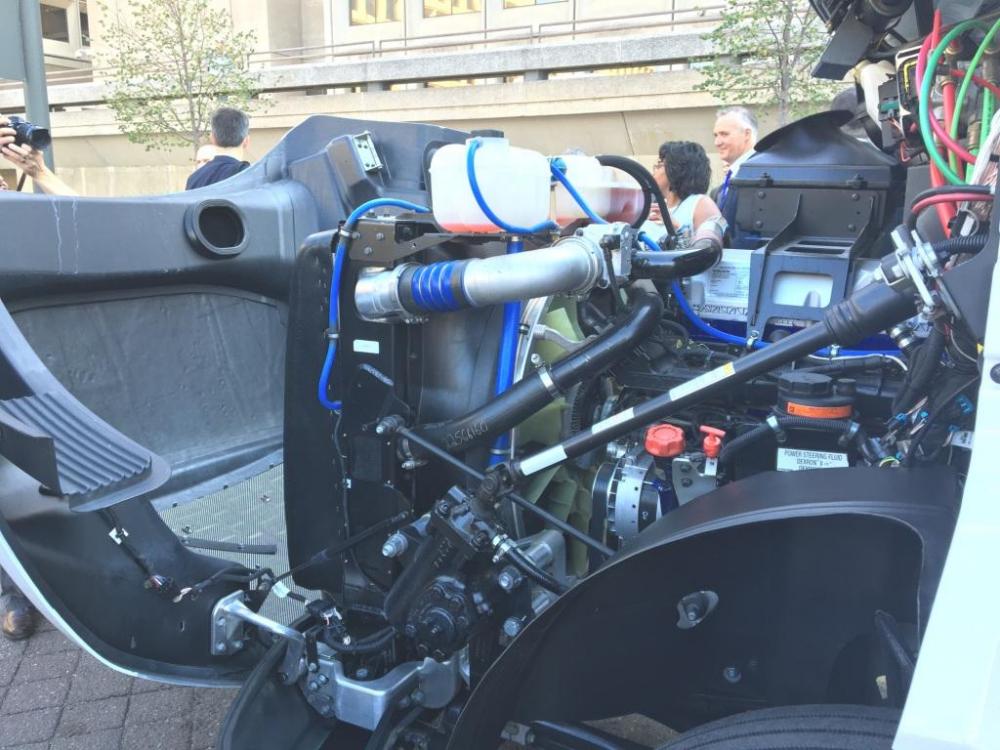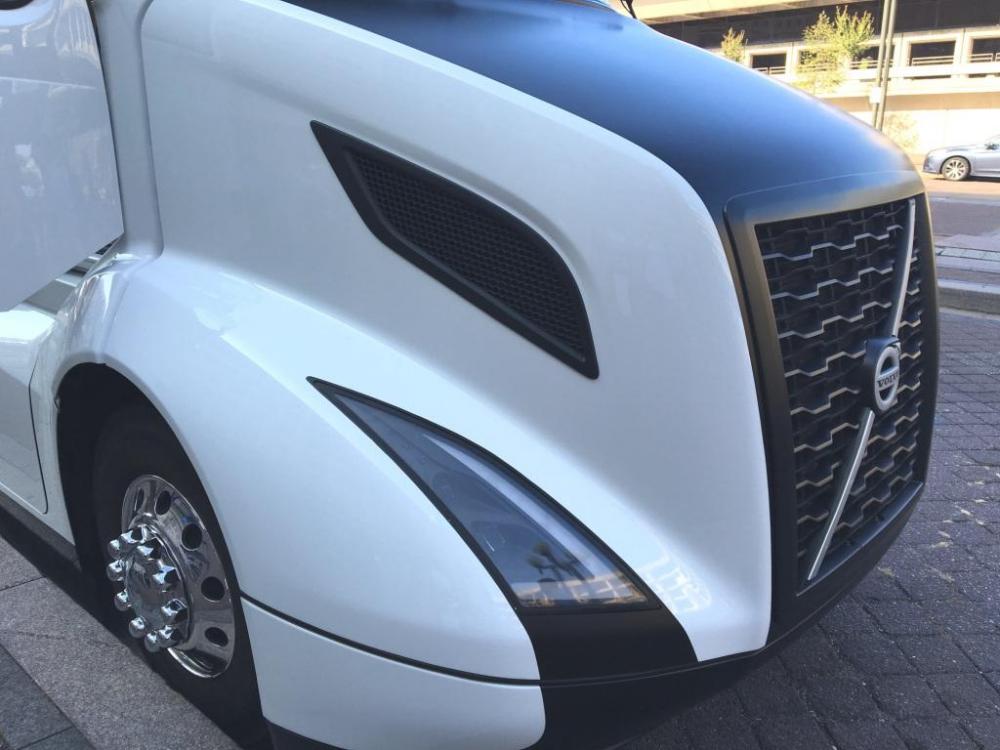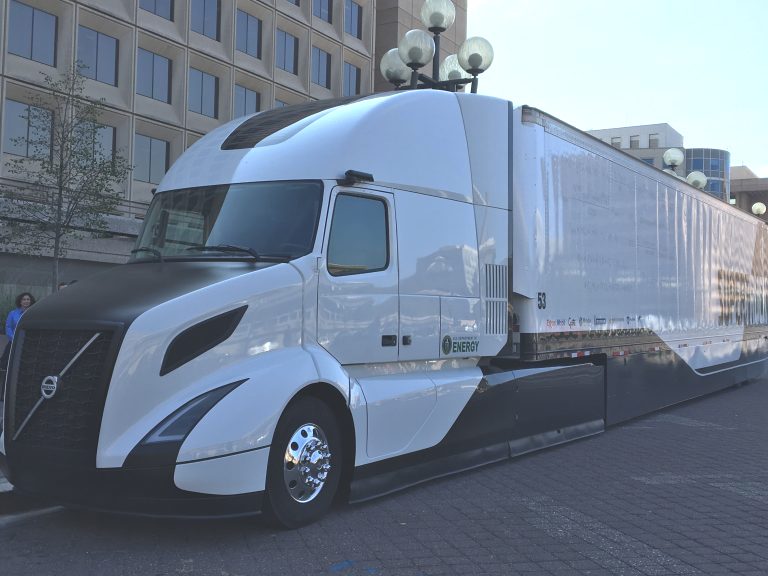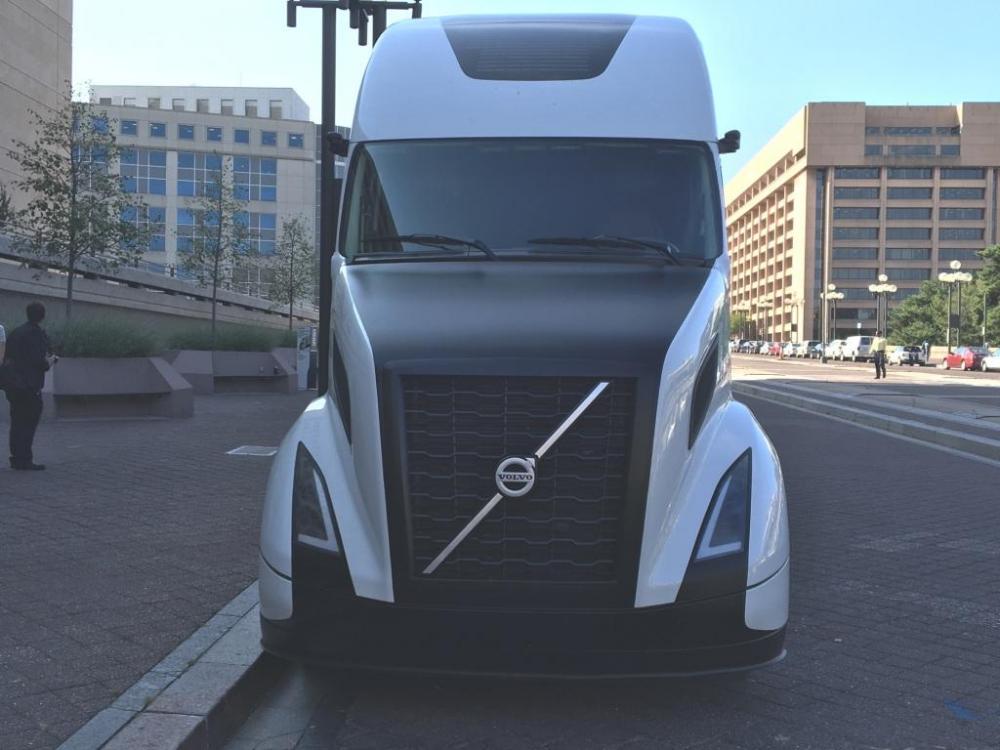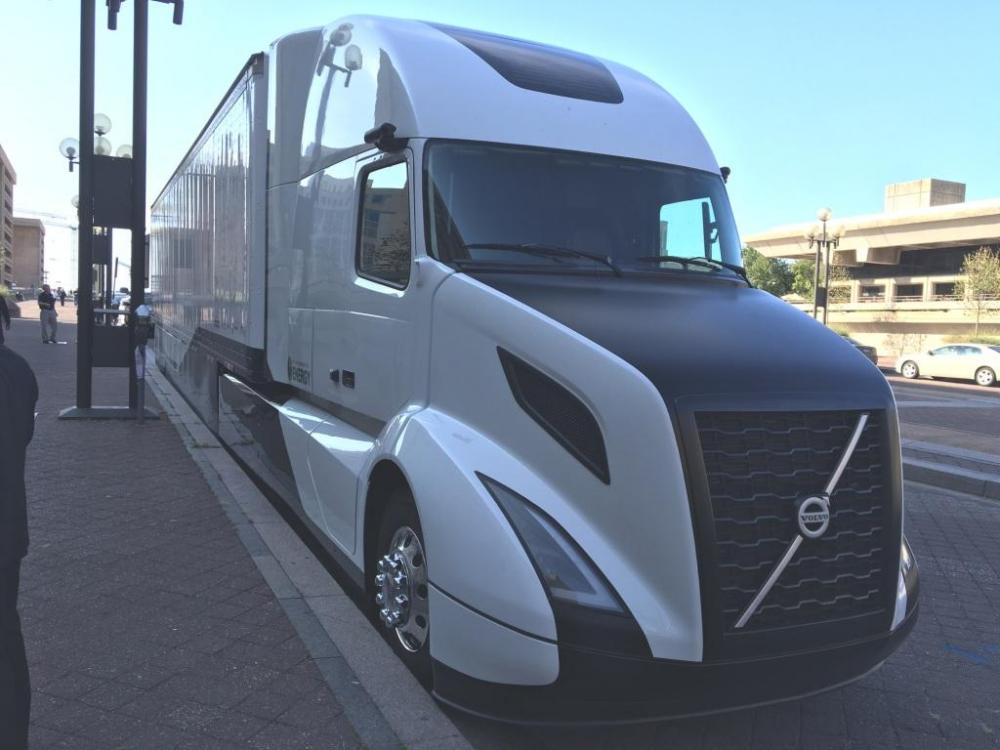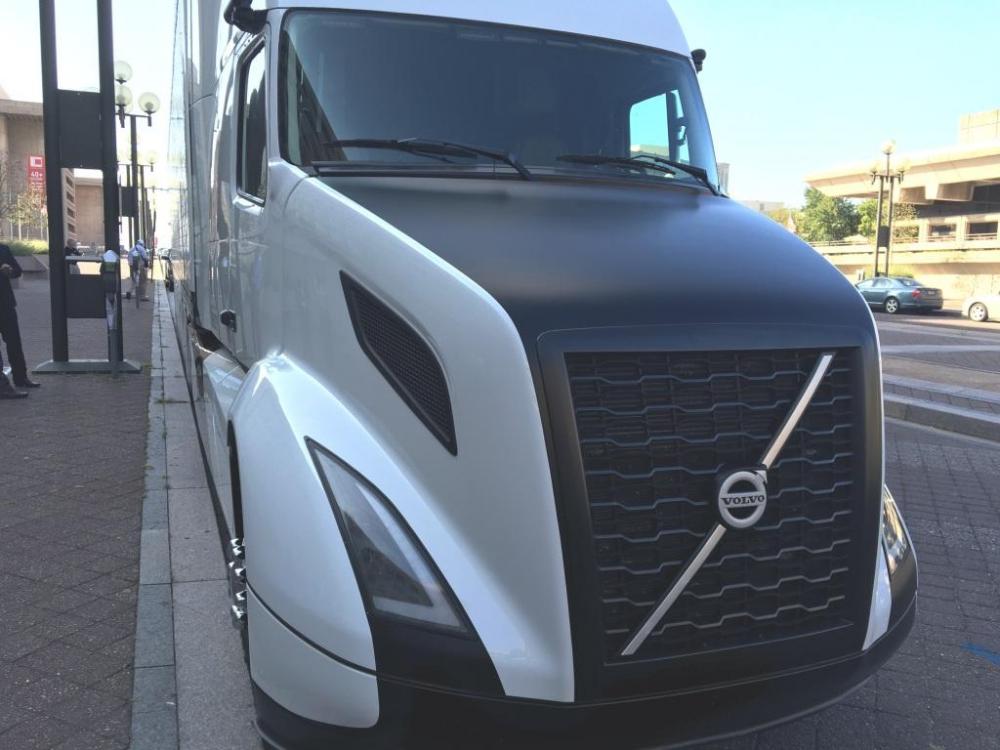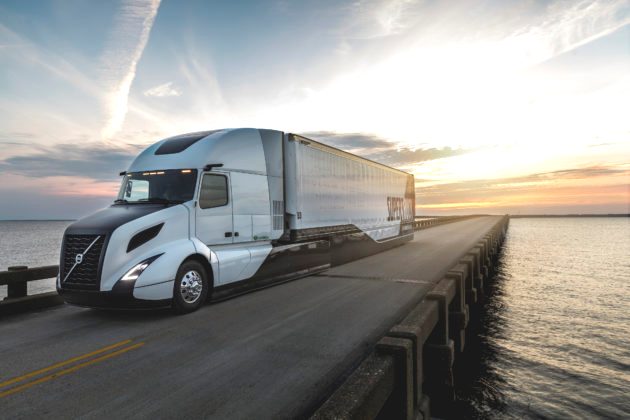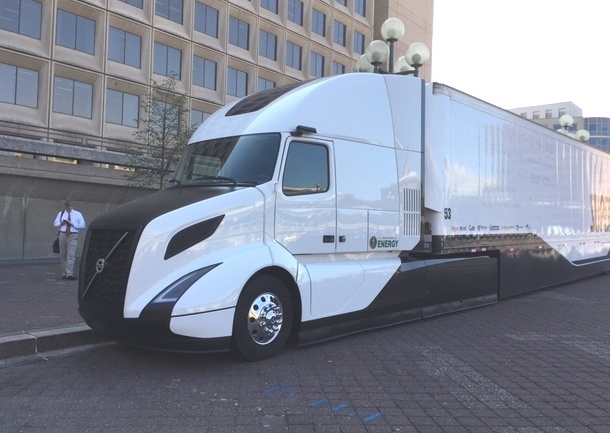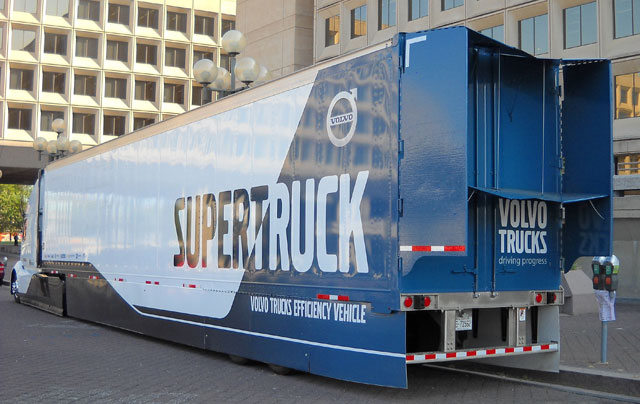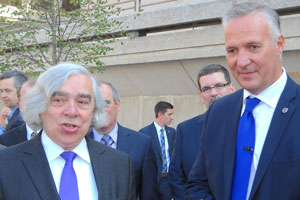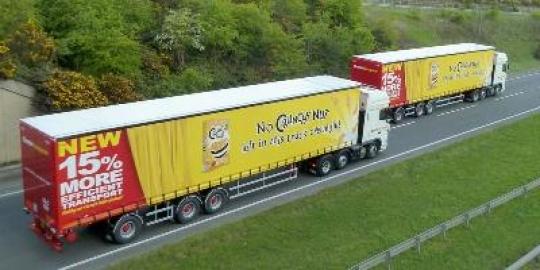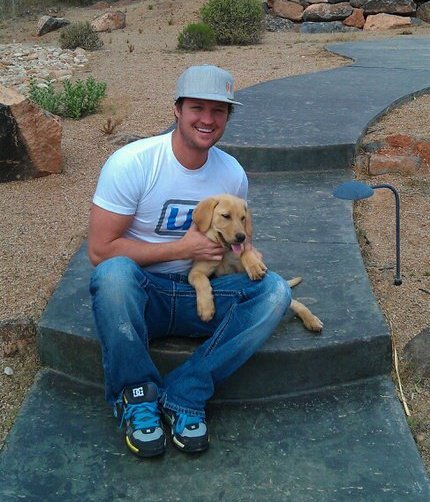
kscarbel2
Moderator-
Posts
17,893 -
Joined
-
Days Won
86
Content Type
Profiles
Forums
Gallery
Events
Blogs
BMT Wiki
Collections
Store
Everything posted by kscarbel2
-
Volvo Shows Off SuperTruck Entry to Energy Secretary Ernest Moniz
kscarbel2 replied to kscarbel2's topic in Trucking News
Volvo hits 13 mpg with SuperTruck Truck News / September 13, 2016 Truck maker exceeded goal to improve freight efficiency by 50% Many of the improvements built into the newest Volvo trucks and powertrain can be traced back to the US Department of Energy’s US$20-million SuperTruck project. Volvo made the revelation when it took the wraps off its SuperTruck at a press event this morning in Washington, D.C. “Knowledge gained from the SuperTruck product is benefiting our customers today,” said Goran Nyberg, president, Volvo Trucks North America. Examples of enhancements that were developed on the SuperTruck and carried over to Volvo’s production vehicles include: a new aerodynamic bumper; flared chassis fairings on the VN 630 and 670; and an aerodynamically enhanced roof for the 670. Airflow through the engine compartment has also been optimized. As for the powertrain, Volvo’s new patented wave piston design was validated on the SuperTruck, as well as its new common rail fuel injection system and turbo-compounding, which Volvo is rolling out on its D13. The US Department of Energy gave Volvo $20 million to work with and the truck maker matched the funding, and then some. The goal was to improve freight efficiency by 50%, but Volvo exceeded that, bettering it by 88%. It also reduced vehicle weight compared to a 2009 model year VN by more than 3,000 lbs, reduced drag by 40% and improved fuel economy by 70%. Nyberg said testing routinely showed the SuperTruck achieving more than 12 mpg while loaded and with some additional tinkering it has now surpassed 13 mpg. “We thought we had a tough goal of 50% improvement when we started the project but the project has delivered 88%, which is quite impressive,” Nyberg said at the unveiling. Volvo has secured an additional $20 million in funding for its SuperTruck II project, which targets a 100% freight efficiency improvement compared to that same 2009 baseline. However, Nyberg explained the second project requires truck makers to demonstrate a one- to two-year payback on technologies used to get there, so it will have to eliminate some of the costlier systems that were deployed on the first SuperTruck. Pascal Amar, senior project manager with Volvo Group North America, was in charge of overseeing the first SuperTruck project. “SuperTruck was a chance to look into the future as a truck manufacturer,” he said. “It gave us the possibility to look at what was coming and really start analyzing some of these trends we’re picking up on.” Amar said the project began from the rear, with an analysis of the trailer and how the tractor interacts with it. Volvo chose to work with an existing trailer design rather than something more futuristic such as a teardrop-shaped trailer. “We didn’t want to go too crazy and design something that wouldn’t be realistic,” he noted. Volvo worked with Ridge Corp. to design an aerodynamic gap fairing, side skirts and tail fairing. “Once we had the most aerodynamic trailer we could find, we went on to what that meant for the tractor,” Amar explained. A lesson learned along the way was that the relationship between the tractor and trailer was more complex than first thought. “We found things that we thought would help the tractor be more aerodynamic but they would only help if the trailer was a certain way,” Amar explained, citing a lower front bumper fairing as one example that didn’t pan out. Volvo maintained its existing steel cab structure, but repositioned it. The cab sits about three inches higher and eight inches further forward and has a shorter hood. The rear cab wall was widened to better direct air around the trailer. The front grille was rounded slightly, the bumper made curvier. With truck aerodynamics addressed, changes to the powertrain were required. The sleeker truck sliced through the wind more easily and as a result, required less power to push it down the road. Volvo opted for a D11 engine. “It’s really about right-sizing the powertrain,” Amar said. “Picking the size of engine that is just right for this truck so we can operate the engine where it’s efficient in the sweet spot.” The Volvo powertrain achieved 50% brake thermal efficiency, compared to the baseline of about 42%, meaning about 50% of the fuel used is now converted to usable power. Weight was reduced through the use of lighter-weight materials. The aluminum frame, for example, is 45% lighter than the 2009 production steel frame. But designers didn’t just swap out steel for aluminum, Amar stressed. “The novelty is in how they used the material,” he said. “They designed the frame to take advantage of the properties of aluminum.” The frame alone shaved 900 lbs out of the vehicle. A total of about 4,700 lbs was taken out, but the installation of new technologies put back about 1,500 lbs, resulting in a net weight savings of 3,200 lbs. While carbon fiber is known for its lightweight characteristics, it’s also known for its high price tag. Volvo sought alternative materials that were less expensive than carbon fiber. The company also considered the driver. It designed a fully-integrated hotel load power system that provides temperature control and power for 14 hours without idling or depleting the batteries. Volvo studied telematics-derived data to see how its trucks are being operated over the road and tailored its system to reflect these realities. Two belt-driven alternators engage when the truck is travelling downhill, is accelerating and slowing down and use this energy to keep the batteries fully charged throughout the drive cycle. When the driver stops, a full 14 hours of power and climate control are available. The bunk windows were scrapped, because Volvo found they were a source of heat or chill loss. But a solar panel on the roof powers LED lights inside the cab that give the appearance of natural daylight. A hot air extractor on the roof also spits out hot air from inside the cab, keeping the inside temperature comfortable. The SuperTruck was shown to US Energy Secretary Ernest Moniz, who seemed genuinely impressed by the result. But despite exceeding the goals laid out through the project, Amar said Volvo isn’t calling it a day. “Testing hasn’t stopped,” Amar said. “Our contract with SuperTruck 1 ended in June, but we haven’t stopped working on it. We keep finding new improvements and keep testing things. We have a lot of ideas we want to throw at it for SuperTruck II.” The second SuperTruck project will build on lessons learned during the first project, but will result in a completely new truck. And because all technologies used must demonstrate a quick payback, it’s likely the second project will also see improvements carried over to production trucks. -
Volvo Shows Off SuperTruck Entry to Energy Secretary Ernest Moniz
kscarbel2 replied to kscarbel2's topic in Trucking News
Commercial Carrier Journal (CCJ) / September 13, 2016 . . -
Volvo Shows Off SuperTruck Entry to Energy Secretary Ernest Moniz
kscarbel2 replied to kscarbel2's topic in Trucking News
-
Volvo Shows Off SuperTruck Entry to Energy Secretary Ernest Moniz
kscarbel2 replied to kscarbel2's topic in Trucking News
Volvo SuperTruck achieves at least 12 mpg Today’s Trucking / September 13, 2016 Volvo Trucks has unveiled its truck of the future, and it’s already applying many of the underlying lessons on the trucks of today. The SuperTruck – developed through a five-year research project with the U.S. Department of Energy – boasts an astounding 12 miles per gallon (19.6 liters per 100 kilometers). After a few tweaks to the design, company engineers have even seen it exceed 13 miles per gallon (18 liters per 100 kilometers) in selected tests. Compared to a 2009 Volvo VNL tractor, the new design is 3,200 pounds lighter, produces 40% less drag, and boosts freight efficiency by 88%. The latter measure reflects the tons of freight that are moved to the fuel that is burned. The project’s original goal was to improve the freight efficiency by 50%. “That is a big number that we did not anticipate when we started the project,” says Pascal Amar, senior project manager, Volvo Group North America. But rather than building a concept vehicle alone, Volvo says it focused on making changes that could come to the market in the short term. Unlike SuperTrucks from other manufacturers, this one did not rely on hybridization. Costly carbon fiber materials were shelved as well. “We looked at the SuperTruck project as kind of a knowledge accelerator,” says Goran Nyberg, president of Volvo Trucks North America. That means bringing new technology to the marketplace more quickly. The engine’s wave piston, turbo compounding, and common rail fuel injection systems have already been introduced in the company’s 2017 engine lineup, boosting fuel efficiency by up to 6.5% in the process. Flared chassis fairings, a redesigned bumper, and air deflectors have also been incorporated into Volvo VNL tractors now on the market, improving their fuel efficiency by up to 3.5%. Of course, the SuperTruck also offers insights into technology to come. Cameras, for example, have replaced mirrors in the search for better air flow. One of the most prominent of the futuristic features is a Rankine waste heat recovery system, mounted above the transmission and in front of the battery box. That achieves a 50% brake thermal efficiency, which means half the energy in the fuel actually makes it to a dyno. Inside the cab, hotel loads are powered using a solar panel incorporated into the roof line, and a pair of belt-driven alternators that captures kinetic energy as a truck rolls down the road. “We trickle charge the batteries when the truck is driving,” Amar says. Together, they offer 14 hours of power for things like air conditioning. And while the reshaped roofline and solar panel eliminates the skylight, the space inside the cab is now lit with a virtual skylight that’s powered with LEDs. The truck’s shape itself is also decidedly futuristic. “You don’t get 40% less drag with just a few fairings,” Amar explained. The truck builds around a traditional VNL steel cab, but sits three inches taller and moves forward eight inches, ensuring a straighter flow of air up the front of the truck. A wider back wall also creates a wedge that directs air around the tractor and to the back of the trailer. Meanwhile, the trailer itself includes a boat tail, side skirts, and reshaped front end. By mounting the air conditioner’s condenser at the back of the cab, engineers were also able to introduce a smaller grill at the front of the truck. Other gains were realized by “right-sizing” the engine, and opting for a 425-horsepower D11. “You operate the engine where it’s efficient, in the sweet spot,” Amar says, referring to the change that can be made without sacrificing performance. Meeting and exceeding targeted weight savings (the original goal was to be 40% lighter, but the SuperTruck weighs 45% less) was made possible in part with an aluminum frame that is 900 pounds lighter than its predecessor. The weight savings were also realized despite new technologies that were added to the truck. About 4,700 pounds were removed, but 1,500 pounds had to be added. Still, there were some curves to address along the way, and not simply in the form of reshaped fairings. “The interactions between the trailer and tractor were much more complex than we thought,” Amar says, referring to how that led engineers to abandon plans for a lower front bumper. Fuel cells to power the hotel loads were replaced with the system that uses solar panels and captures kinetic energy. Plans for an adjustable fifth wheel were abandoned altogether because they simply wouldn’t generate the expected returns. And while carbon fiber was researched, it was left to future projects. “When a truck becomes this much more efficient, this much more aerodynamic, a lot of assumptions need to be revisited,” he added. The idea of capturing a truck’s kinetic energy, for example, could be at odds with systems like predictive cruise control that are also designed for fuel economy. “Do you disengage the driveline and coast, or do you charge the batteries?” Engineers have little time to rest in the search for answers to questions like that. Volvo is among manufacturers that will also participate in the second phase of the research known as SuperTruck II, leveraging US $20 million in federal funds with the goal of doubling ton miles per gallon when compared to the 2009 baseline, and creating a powertrain with a brake thermal efficiency of 55%. “We will make sure that this program will be successful and we will bring more value to our end users,” Nyberg says. Partners in the project include Michelin Americas Research Company (tires), Wabash National (trailer), Metalsa (lightweight frame), Johnson-Matthey Inc. (exhaust aftertreatment system catalysts), Oak Ridge National Laboratory (exhaust aftertreatment system testing / analysis), Peloton Technology (connected vehicle / platooning), Pennsylvania State University (connected vehicle testing), Knight Transportation (long-haul fleet), and Wegmans Food Markets (regional-haul fleet). “We have a lot of ideas we want to throw at SuperTruck II,” said a clearly excited Amar. “We generated so much more innovation through the project. It just keeps going.” . -
Volvo Shows Off SuperTruck Entry to Energy Secretary Ernest Moniz
kscarbel2 replied to kscarbel2's topic in Trucking News
Volvo’s SuperTruck Exceeds EPA Freight Efficiency Goals Heavy Duty Trucking / September 13, 2016 Volvo Trucks North America’s SuperTruck demonstration rig combined advanced aerodynamics, vehicle and powertrain technologies to achieve a freight efficiency improvement of 88%, exceeding the 50% improvement goal set by the U.S. Department of Energy SuperTruck program compared to a base model 2009 Volvo VN. From the top-of-cab solar panels powering its battery and interior lights, to its ultra-light aluminum frame and highly advanced 425 horsepower 11-liter proprietary engine, the SuperTruck concept vehicle allowed Volvo engineers to push the boundaries of heavy truck efficiency. The sleek tractor-trailer combination boosted fuel efficiency by 70%, exceeding 12 mpg consistently in testing, with some test runs showing more than 13 mpg. Powertrain brake thermal efficiency reached 50%. Göran Nyberg, president of Volvo Trucks North America, noted that the base model Volvo in 2009 averaged 7 mpg. The SuperTruck program was a five-year DOE research and development initiative to improve freight efficiency – meaning more payload carried while burning less fuel – by 50% compared to 2009 base model trucks. Volvo’s aerodynamic SuperTruck has a shorter front end than conventional trucks on the road today, and the hood has a sharper downward slope. Lightweight fairings run the length of the tractor and trailer, and cameras have replaced rearview mirrors. Its redesigned chassis is made almost entirely of aluminum, which halved the chassis weight and contributed to an overall tractor-trailer weight reduction of 3,200 pounds. An enhanced version of Volvo’s I-See, a new feature that memorizes thousands of routes traveled and uses that knowledge to optimize cruise speed and keep the I-shift automated manual transmission in the most fuel-efficient gear possible, was an integral part of the fuel efficiency gains seen during SuperTruck on-road testing. A key part of the overall efficiency gain is the downsized 11-liter Volvo engine, featuring advanced fuel injection, cooling, oil and turbo-charging systems, as well as new “wave” pistons and other improvements. The SuperTruck powertrain includes a complex Rankine waste-heat recovery system, which converts heat normally wasted in exhaust into torque, boosting fuel economy by helping to power the vehicle. “The order of magnitude efficiency leap achieved by our SuperTruck is a testament to the outstanding work done by our team and our partners,” said Pascal Amar, principal investigator for the project. “We started by rethinking everything, and we discovered that with every layer you peel back, you uncover new opportunities.” While not every technology demonstrated in the Volvo SuperTruck will be commercialized, three of the engine advancements developed through SuperTruck research – the wave piston, turbo compounding system and common rail fuel injection system – are already featured in Volvo Trucks’ 2017 engine line-up. Likewise, a number of SuperTruck-derived aerodynamic improvements – like flared chassis fairings improving air flow around the drive wheels, a redesigned bumper and turbulence-reducing deflectors – can be found on today’s Volvo VNL tractors. Volvo used computer-aided engineering to reimagine nearly every part of the tractor and trailer without costly prototyping. While the VNL “body in white” was mostly maintained in order to save time and ensure structural integrity, everything else – including the front end, the cab exterior pieces, the chassis fairing and the roof – were completely redesigned to maximize the aerodynamics of the tractor-trailer combination. Not every idea made it to the concept vehicle. Working with suppliers and academic partners, the team explored the performance and safety of a number of lightweight materials. While some of these, like recycled carbon fiber, were not used in the SuperTruck, the knowledge gained in material science will be applied to future programs. The DOE recently selected the Volvo Group to participate in DOE’s SuperTruck II program, which will target a 100% improvement on a ton-mile-per-gallon basis, and a powertrain capable of 55% brake thermal efficiency. Watch for a more detailed report from HDT Equipment Editor Jim Park, who was there for the unveiling of the SuperTruck in Washington, D.C. . -
Transport Topics / September 13, 2016 Volvo Trucks North America unveiled its version of SuperTruck for inspection here by Energy Secretary Ernest Moniz on Sept. 13, saying its VNL 670 highway tractor demonstrates an 88% gain in freight efficiency and an extra 70% in fuel efficiency. On the same day that VTNA showed off its results from SuperTruck Phase 1, the original equipment manufacturer also said it has been selected to receive another $20 million for Phase 2 of the Department of Energy research program. DOE spends the money, which must be matched dollar-for-dollar by OEMs, to develop heavy-duty trucks that are more fuel efficient, thereby conserving energy and reducing diesel emissions. “I’m very excited about this SuperTruck initiative. . . It’s important for the United States, but this is drawing international attention as well,” said Moniz, who has been secretary since May 2013. Moniz, who knew that 81% of U.S. freight, as measured by revenue, travels on trucks, said doubling fuel efficiency “is a big deal.” He said the most complex systems, such as waste-heat recovery, “are going to take longer to be part of the commercial offerings. But we want to see these technologies entering, not as, like, one SuperTruck from any of the vendors, but as a set of technology lessons incorporated with time as the costs come down.” VTNA President Göran Nyberg led Moniz on the inspection tour, along with several of the OEM's engineers. “This is a knowledge accelerator,” Nyberg said of SuperTruck at a press briefing prior to the DOE event. He said the research produced a 6.5% increase in fuel efficiency through powertrain optimization and an additional 3.5% gain through better aerodynamics. Using a 2009 Volvo as a baseline, miles per gallon rose to 12, on average, from 7 mpg. By changing some steel components to aluminum and introducing carbon-fiber materials, the Volvo SuperTruck dropped 3,200 pounds in net weight, helping to increase fuel efficiency — ton-miles traveled per gallon of fuel used — by 88% over the 2009 baseline. While SuperTruck 1 focused on linehaul applications, Phase 2 will offer more for regional applications, VTNA Senior Vice President Susan Alt said. The DOE grant to Volvo, which must be funded by Congress to become official, calls for the company to increase fuel efficiency by using alternative engine designs and lightweight tractor-trailers. Volvo must match the $20 million it gets from DOE. The OEM will work with truckload carrier Knight Transportation and grocery chain Wegman’s Food Markets to test new systems for SuperTruck 2. The research program coincides with federal regulation of greenhouse-gas emissions of heavy- and medium-duty trucks by the Environmental Protection Agency and the National Highway Traffic Safety Administration. Nyberg said VTNA’s 2017 powertrains, which comply with Phase 1 of GHG rules, include several components that were developed as part of SuperTruck 1, specifically, wave pistons that minimize unburned fuel; a common-rail, fuel-injection system; and turbo compounding, an elementary form of waste-heat recovery. In August, EPA and NHTSA released their final version of Phase 2 of GHG regulation, a rule that will tighten emission standards on trucks in 2021, 2024 and 2027. More technology developed in SuperTruck 1 and 2 will help the manufacturer meet those standards, Nyberg said, but he declined to specify which innovations are closest to introduction. “There’s enough meat on this,” Nyberg said of the research results. .
-
ATA, OOIDA ask for more time on speed limiters Fleet Owner / September 13, 2016 Trucking groups cite NPRM's complexity, 'significant' impact The two largest trucking trade associations each have asked the Dept. of Transportation for more time to study the recently published truck speed limiter proposal, citing the rule’s complexity, changing industry dynamics, and the “significant” impact of such a regulation. In Sept. 9 letters to Transportation Secretary Anthony Foxx, the American Trucking Assns. (ATA) and the Owner-Operator Independent Driver Assn. (OOIDA) made their respective cases for an extended public comment period. “The rule, as proposed, would have a significant impact on the whole of ATA’s membership and many more industry participants,” writes ATA, which had petitioned for a speed limiter mandate 10 years ago. The organization and its state affiliates, along with the Truckload Carriers Assn. (TCA), note that “much has changed in vehicle and motor carrier safety” over the decade. The letter points to the development and adoption of safety technologies, the greater scrutiny of carriers under the Compliance, Safety, and Accountability program, and electronic logs as examples. “These developments, along with new state laws and speed limits, have changed the way motor carriers view and respond to safety concerns,” ATA says. Additionally, ATA points to the proposed rule’s “dramatic departure” from the initial petition, in terms of tamper proofing protections, the lack of a retrofit requirement, and the DOT’s reluctance to specify a governed speed. ATA requests an additional 30 days “to reengage its membership” on the matter. OOIDA, which represents small business truckers, asks for a 60-day extension of the comment period, citing the “wide range of issues” related to limiting truck speed and noting that the proposal is “based on complex research that in some instances is being used in an unconventional way.” “This is one of the most significant NPRMs in decades as it relates to the safety of the traveling public, roadway efficiency, and the livelihood of our nation’s professional truck drivers,” OOIDA writes. “One way or another, the outcome of this NPRM will impact everyone.” The comment period is currently scheduled to run through Nov. 7. Comments may be filed at regulations.gov.
-
Freightliner introduces next-generation Cascadia
kscarbel2 replied to kscarbel2's topic in Trucking News
. . -
Not my bus. I posted another gentleman's comments in italics (with a link to that web page), because he was very informative on the subject.
-
The Australian vocational market is shaped quite differently from the US market. Refuse has similarities, but you have the superb Acco, and also Dennis Eagle competing.
-
Bob, the Australian on-road CAT truck effort was/is unaffected by the discontinuation of the U.S. market vocational trucks. Alike Detroit Diesel (the 2-strokes and 60 series) the CAT name carries a lot of weight in Australia. They have a fantastic and deep-pocketed distributor in WesTrac too. http://www.bigmacktrucks.com/topic/41154-all-systems-go-for-cat-trucks-australia/#comment-298395 http://www.bigmacktrucks.com/topic/41412-cat-reinforces-commitment-to-australian-market/#comment-300632
-
BBC / September 13, 2016 Three Syrian men have been arrested in Germany on suspicion of being sent by ISIS to launch attacks. The men - aged 17, 18 and 26 - were detained after a series of pre-dawn raids in the states of Schleswig-Holstein and Lower Saxony on Tuesday. Police have seized "extensive material". Investigations so far indicate the three men came to Germany in November 2015 with the intention of "carrying out a previously determined order [from ISIS] or to await further instructions". The men traveled through Turkey and Greece on false passports. Investigators believe the men volunteered for the mission, and the 17-year-old was trained in handling weapons and explosives. They were arrested when 200 police and security officers raided several premises including three refugee shelters.
-
Elbow greased the Superliner
kscarbel2 replied to gearhead204's topic in Exterior, Cab, Accessories and Detailing
If you're going to compound and polish a truck, you owe it to yourself to make the task considerably easier and faster, while also getting a better result, by buying a Meguiars dual-action MT300 buffer. After washing and claying the truck, you can start out with Poorboys SSR 2.5 or 3 (compounding), depending on how bad it is, and then apply SSR 1 (polishing/swirl removing), using the appropriate buffer pads. Last, apply a long-lasting Menzerna Power Lock Polymer sealant (synthetic wax) by hand. https://www.amazon.com/Meguiars-MT300-Pro-Power-Polisher/dp/B00OTK5JHG/ref=sr_1_2?ie=UTF8&qid=1473754268&sr=8-2&keywords=meguires+buffer https://www.amazon.com/Meguiars-DBP6-6-Backing-Plate/dp/B00PYCXGQE/ref=pd_sim_263_6?ie=UTF8&psc=1&refRID=711GG8MNMW2ZANBC4MSZ -
UK says longer semi-trailers are safer and more efficient
kscarbel2 replied to kscarbel2's topic in Trucking News
UK Department for Transport (DfT) may extend longer semi-trailer trial as benefits mount Commercial Motor / September 12, 2016 The government is considering extending the longer semi-trailer pilot, despite the latest annual report revealing that the full allocation is still not running on UK roads. According to the fourth annual report, 1,674 of the full allocation of 1,800 longer semi-trailer permits were in use as of July 2016; an increase from the 1,511 at the end of 2015. The DfT said another 100 longer semi-trailers have either been issued with their vehicle special orders, required to use a longer trailer on the public highway, or are currently in build. With the full trial allocation almost reached, the DfT has also started “consulting trade associations and participants on whether to increase the number of vehicles in the trial”. It is also seeking views on whether the trial should be extended. Since December 2015, the number of operators with longer semi-trailers on the road has increased from 151 to 163, and the report predicted that operating longer semi-trailers had saved up to 10.6 million vehicle km since the trial began in 2012. The report added: “There is no evidence that the safety risk from longer semi-trailers is worse than that of normal HGV trailers.” Transport minister John Hayes said: “Lorries are the engine of our economy and this pilot scheme is helping hauliers deliver the day-to-day goods we need more efficiently.” “Road haulage efficiency is vital to the economy and keeping the UK competitive,” said RHA director of policy Jack Semple. “After the Brexit vote, there is an increased awareness that we should be embracing every opportunity for productive innovation, where it is safe to do so.” “This report confirms the value of longer semi-trailers,” Jack Semple continued. “It also confirms the RHA’s prediction that there would be no great rush for the new lengths and that take-up would be gradual, with 15.65 metre trailers much the more popular length. “There are now 151 operators in the trial. But it is clear from our members that both existing longer semi-trailer operators and other hauliers could make good use of more of these trailers, and the government should release more permits to allow them to do so. It should allocate permits, as before, in a way that gives equal opportunity to smaller firms.” . -
'81 F on Ebay
kscarbel2 replied to Superdog's topic in Antique and Classic Mack Trucks General Discussion
No. That truck has been painted in the past. The donor truck was old......look at the underslung 34,000lb rear suspension. They rode smooth as a Cadillac, but they sagged as well. Worst of all, it has wedge brakes. I would only buy that truck to obtain the cab, though it has seen weather. I see the right roof clearance lamp lens is missing, meaning some water might have been entering there. That could explain why the headliner is destroyed on the passenger side. -
http://townhall.com/columnists/johnhawkins/2016/09/10/how-to-destroy-america-from-within-n2216092
-
Truck Design 101 - Ergonomics
kscarbel2 replied to kscarbel2's topic in Modern Mack Truck General Discussion
When you say author, are you referring to me? About Navistar's MaxxForce engines, they are license-built MAN D20s and D26s (since 2005). Scania has no connection with Navistar and those engines. Those MAN engines are very good powertrains though. The issue arose when Navistar's own engineers, under former CEO Dan Ustian's orders, tried to go the MEGR (Massive EGR) route, meaning EGR levels from 35% to 50%, to meet EPA2010. Scania engines are extremely good. In fact, the superb V-8 is legendary. -
You're right BC. This is all a bunch of BS. This fellow is full of it.
-
Dagens Industri / September 13, 2016 Volvo and Scania may be tough competitors. But to develop the production of heavy powertrains, they shall cooperate in a new research lab. The lab is backed by German experts from research organization Fraunhofer (https://www.fraunhofer.de/en.html). The new research center at the KTH Royal Institute of Technology in Stockholm, called Powertrain Manufacturing for Heavy Vehicles Application Lab, will be inaugurated on Tuesday. In addition to Fraunhofer and the KTH Royal Institute of Technology, the lab will be supported by the RISE Research Institutes of Sweden (http://www.ri.se/en/about-rise). Partners Scania, Volvo and tool supplier Sandvik Coromant (http://www.sandvik.coromant.com/en-us/pages/default.aspx) will invest about 10 million each. Fraunhofer’s vast organization includes 24,000 employees operating at 67 institutes in Germany. With a turnover of nearly 20 billion, Fraunhofer is Europe's leading organization for applied research. "Swedish industry and academia came to Fraunhofer and wanted to cooperate. We are a German organization with a mission to support German industry, but we also see it as important to increase innovation throughout Europe, "said Jannik Henser, managing director of the new research lab. The lab also coordinates a research and development cluster which includes Chalmers University of technology in Gothenburg. The plan is to bring in more business as a partner. The research should primarily focus on improving the production process. This may involve material selection and machining of camshafts and engines. "This laboratory will be a gateway to the collective expertise of the Fraunhofer Institutes in terms of applied manufacturing technology," says Jan Ohlsson, head of the Volvo Group's production organization for trucks and powertrains. The first steps were taken three years ago when both Volvo, Scania and Sandvik found ways to cooperate with Fraunhofer. "It has previously been a bit difficult to unite the industry in the East and the West on the issue," says Lars-Henrik Jörn Wing, director of the global industrial development at Scania. He sees no problem with competition issues. "We believe that we can do a great deal of research and development together. It is not primarily a competitive tool, but a way to strengthen the industry in Sweden. "
-
Volvo risks business fine Dagens Industri / September 13, 2016 Volvo's transfer of its management consulting business to ex-employees violates stock market regulations and raises the prospect of fines. The Securities Council interprets the Leo Act stricter than the courts. "We can try Leo Act applicability outside the law. There are many examples of cases which lies on the border where we felt that Leo Act should be applied," says Rolf Skog, head of the Office of the Securities Council. It was last Saturday that Dagens Industri revealed that a group of ex-Volvo employees had replaced the truckmaker’s internal unit of management consultants instead of searching on the open market. The former Volvo employees set up the company Fortos Management Consulting AB, and described the deal as such in its annual report: "The company started its operations during the year in the form of a transfer of operations from Volvo Group in which Fortos Management Consulting took over the employees and service." Thirty Fortos employees have continued to work for the truck giant's top executives, and made millions the first year for a few months of operation. Volvo refused to comment on the terms of the settlement. Normally, under the Leo Act, the subject of a sale or transfer of employees must be approved by the shareholders at a general meeting. "If the deal infringes on the Leo Act, it may be declared invalid - it is so as to violate the Securities Council's recommendations usually receive a disciplinary punishment of the stock market," says Johan Munck, former justices and president of the Supreme Court. A basic requirement from the Swedish Securities Council is that there be an independent valuation before the transaction. Rolf Skog would not comment on the panel that is beginning an investigation of the Volvo deal. "We look at what we in different ways will be made aware of. It is enough to say so."
-
Trevor Milton wants to revolutionize trucking, and he doesn’t care if you don’t believe him Commercial Carrier Journal / September 9, 2016 Trevor Milton has been in the trucking industry for the better part of six years, but his big break came – like a meteorite through a skylight – earlier this year when he announced plans to build an electric Class 8 truck. Milton founded Nikola Motor Company (NMC) two years ago, named in homage to engineer and inventor Nikola Tesla. With the looming December launch of its electric drivetrain truck NMC is poised to become the Tesla of trucking. It’s fitting that Milton, who has fewer than 200 Twitter followers, only follows one account – Tesla Motor Company boss Elon Musk. Prior to establishing Nikola, Milton was CEO of dHybrid Systems, a company that made natural gas storage technology for trucking that was acquired in October 2014 by Worthington Industries. But Milton isn’t your typical trucking CEO. A co-founder of five start ups, he considers himself a “serial entrepreneur” and is fluent in Portuguese, English and is semi-fluent in Spanish. He also brings his dog to work every day. While at dHybrid Systems, he directed the engineering team and design processes that produced, among other things, “the fastest filling receptacles ever introduced into the natural gas market.” Unlike his electric passenger car contemporary Musk, who is a graduate of the University of Pennsylvania and the Wharton School of Business, Milton didn’t attend college. “I gained all my knowledge in the real world,” he says. “Working with all the different companies and it’s just how I learned. Everyone learns differently and my talents for learning are in-hand. I like to learn by touching things.” Nikola burst onto the scene in May of this year with promises of a fully electric, 2,000 horsepower Class 8 truck that provided an asphalt crumbling 3,700 ft. lbs. of torque after. That’s Thirty. Seven. Hundred. An on-board CNG turbine was supposed to provide a range of 1,200 miles to the truck’s 320 kWh battery pack. Next came the promises of zero emissions, an attractive buzzword as the EPA unfurled its Phase II emissions regulations in August. Then came a range extending hydrogen fuel cell, which just four months following its initial announcement supplanted a CNG turbine that will no longer be offered in the U.S. or Canada on the Nikola One tractor. “Hydrogen is more efficient and there’s no emissions on it,” Milton says. “It’s 100 percent zero emissions. The end goal, and the desire of us, is to be 100 percent emission free.” The conversion to a hydrogen fuel cell also came with horsepower and torque downgrades. Milton says the company was forced to reconfigure horsepower output from the 800V AC motors to 1,000 and dial down torque to 2,000 ft. lbs. “The amount of torque and horsepower we had was destroying tires,” he says, adding the output comes from a change in the truck’s software. “It’s all software limited. The truck’s still able to output that power.” Equipped with a hydrogen fuel cell, the truck kept its 1,200 mile top range claims. In addition to the fuel cell, the batteries are constantly receiving power through rotational energy via regenerative braking technology. The decision to substitute the CNG range extender for hydrogen didn’t come without risk. Milton says more than 8,000 orders were already on the books for the CNG model. Less than a month after the switch was made, Milton says feedback has been mostly positive. Cancellations were practically non-existent and were more than offset by new orders coming in. “There’s better hydrogen credits with hydrogen than there is with CNG,” he adds. The trucking industry is nothing if not traditional, and NMC is further outside the box than any other company currently building trucks. Undaunted, Milton says Nikola One will find its niche with fleets and drivers tired of chasing EPA emission standards and looking to save some money along the way. “It comes down to your bottom line – what does it cost to operate a diesel per month,” he says. “For a full-time driver it’s about $8,000 to $10,000 dollars a month …With our truck, you’re about $5,000 to $6,000 a month.” About 70 percent of NMC’s customers are fleets, including large carriers who have ordered “thousands” of units, Milton says, adding his company’s sales pitch to-date has been not making a sales pitch at all. The majority of Nikola One orders, he says, have come from customer-initiated contact. “We don’t approach anyone. They approach us,” he says. “The customers we’re dealing with right now are customers that have called in to us asking for a meeting for the big fleets, and the rest have just ordered online. We don’t need to go make a pitch. If they don’t see the value in saving billions [of dollars], I don’t want to work with them anyways.” Milton says his company is currently developing the hydrogen infrastructure to support its million-mile “free fuel” guarantee, with 56 strategically positioned hydrogen stations planned across the U.S. and Canada. There is currently a per gallon federal credit to the station owner, allowing Nikola to build those credits into the price of the tractor and give customers the pre-purchased fuel for the first million miles, Milton says. Meanwhile, there’s all those trucks that still need to be built. “Probably three-quarters of the truck [assembly] will be done robotically,” he says. “All the stamping, all the paint, the frame assembly … everything’s done by robotics, and then a human comes in and finishes it up.” Milton struggles to pin down a number of people currently working on the project, but says counting employees of NMC and its partners, “it’s hundreds and hundreds and hundreds.” And those hundreds and hundreds and hundreds of employees have helped push the company, Milton says, to the forefront of its segment. “We’re probably five to 10 years ahead of our competition,” he adds, “and we’ll start full production about 36 months from right now. I’m happy. We’re booked out for many, many years and that’s what everybody’s dream is.” Innovations in trucking are nothing new and with diesel prices fairly low compared to recent history, NMC has its share of doubters for long-term viability. But Milton says there are plenty of differences between his company and those who may have come – or gone – before it. “We’re the only ones with actual orders,” he says. “We’ve got orders, deposits, partners – we’ve got the largest partners in the world. That’s the difference between us and everyone else. We have a product that makes sense and doesn’t need government subsidies.” The development of Nikola One has largely been built and developed with Milton’s money and funding from partners. Milton says the 8,000-plus $1,500 deposits plopped down to secure a model pre-launch is sitting untouched in an escrow account. “Tesla actually uses people’s money and deposit money,” he says. “We don’t. This has all been self-funded and funded by partners. We’re not out there trying to get money to operate.” Milton is currently working to build the NMC sales and service network, the details of which he expects to announce in about 80 days when the sheet is fully pulled off Nikola One – an event he expects will be attended by more than 500 people, including a likely handful of naysayers. “So many people out there called us vaporware,” he says. “They’re going to eat their words.” .
-
http://blog.caranddriver.com/new-spy-photos-mid-engined-c8-chevrolet-corvette-caught-in-profile/#more-326130 http://blog.caranddriver.com/c8-in-2018-the-latest-on-the-mid-engine-chevrolet-corvette/ Photo gallery - http://www.caranddriver.com/photo-gallery/new-spy-photos-mid-engined-c8-chevrolet-corvette-caught-in-profile .
-
B61 FA 505 axle
kscarbel2 replied to M54A1's topic in Antique and Classic Mack Trucks General Discussion
Who is Weldons? Do you have your truck's line sheet with the 1QH front axle arrangement ? 301SQ45A is applicable to FA505 axles from 1963 on. Prior to that, you need a 301SQ32B king pin set. Give the folks at Watt's Mack a call (provider of the BMT website). You can reach them at 1-888-304-6225. -
Scania Group Press Release / September 12, 2016 For the past two weeks, Scania’s Demo Centre in Södertälje has been like a meeting of the European Parliament, as journalists from all over the continent have been bussed in to test drive the New Truck Generation on the test track and surrounding roads. Transport scribes from Germany, Austria, Switzerland, France, Italy, Belgium, the UK, Scandinavia and the Netherlands are among those who have been hopping in and out of the new S and R cabs, with Scania’s demo drivers, product managers and marketing staff looking on like proud, if slightly anxious, new parents. With years of hard work and patient planning leading up to this moment of truth, the Scania employees’ nerves were understandable, though thankfully there was no need to worry. For, judging by the reactions of the journalists that feature in our accompanying film, the new trucks were a big hit. Jan Burgdorf, from Trucker magazine in Germany, was just one of those who were full of praise: “Scania have done a good job with the new trucks. They have made everything better. It’s a really good truck.” Andreas Werner Dick, from Stragü magazine in Austria, was another confirmed fan. “It’s good to see the progress in the driver’s comfort. Driving is a lot of fun as it is very easy to do. I think that drivers in Austria would like to drive a truck like this. It should be a success on the market.” .
-
Truck Design 101 - Ergonomics
kscarbel2 replied to kscarbel2's topic in Modern Mack Truck General Discussion
Scania actually offers several trim flavors regarding instrument panels. I imagine you would enjoy the wood grain version. I wouldn't call the Scania layout car-like, not at all. A truck driver has a different requirement. The next time you're across the pond, take a drive in the new Scania. I wish you'd attend IAA. . Speaking of Boeing cockpits............
BigMackTrucks.com
BigMackTrucks.com is a support forum for antique, classic and modern Mack Trucks! The forum is owned and maintained by Watt's Truck Center, Inc. an independent, full service Mack dealer. The forums are not affiliated with Mack Trucks, Inc.
Our Vendors and Advertisers
Thank you for your support!


